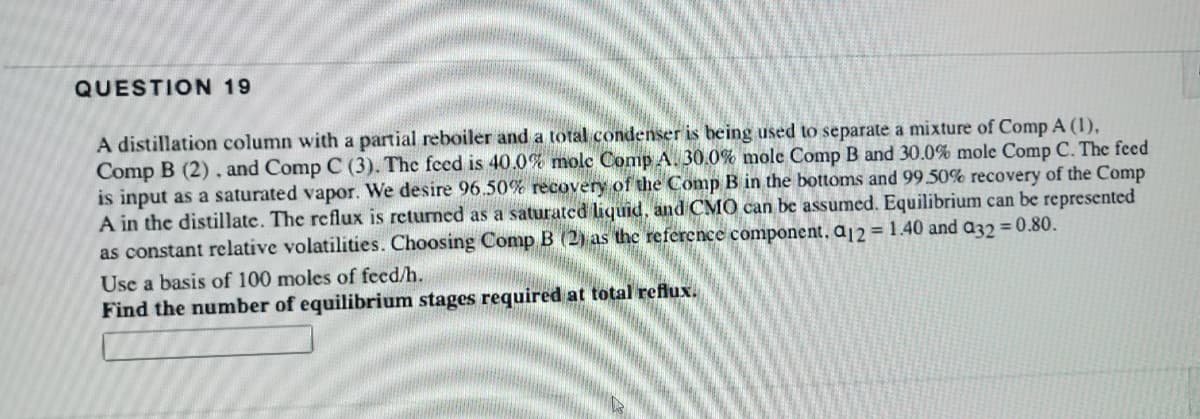A distillation column with a partial reboiler and a total condenser is being used to separate a mixture of Comp A (1), Comp B (2), and Comp C (3). The feed is 40.0% molc Comp A. 30.0% mole Comp B and 30.0% mole Comp C. The feed is input as a saturated vapor. We desire 96.50% recovery of the Comp B in the bottoms and 99.50% recovery of the Comp A in the distillate. The reflux is returned as a saturated liquid, and CMO can be assumed. Equilibrium can be represented as constant relative volatilities. Choosing Comp B (2) as the reference component, a12 = 1.40 and a32 = 0.80. Use a basis of 100 moles of feed/h. Find the number of equilibrium stages required at total reflux.
A distillation column with a partial reboiler and a total condenser is being used to separate a mixture of Comp A (1), Comp B (2), and Comp C (3). The feed is 40.0% molc Comp A. 30.0% mole Comp B and 30.0% mole Comp C. The feed is input as a saturated vapor. We desire 96.50% recovery of the Comp B in the bottoms and 99.50% recovery of the Comp A in the distillate. The reflux is returned as a saturated liquid, and CMO can be assumed. Equilibrium can be represented as constant relative volatilities. Choosing Comp B (2) as the reference component, a12 = 1.40 and a32 = 0.80. Use a basis of 100 moles of feed/h. Find the number of equilibrium stages required at total reflux.
Introduction to Chemical Engineering Thermodynamics
8th Edition
ISBN:9781259696527
Author:J.M. Smith Termodinamica en ingenieria quimica, Hendrick C Van Ness, Michael Abbott, Mark Swihart
Publisher:J.M. Smith Termodinamica en ingenieria quimica, Hendrick C Van Ness, Michael Abbott, Mark Swihart
Chapter1: Introduction
Section: Chapter Questions
Problem 1.1P
Related questions
Question

Transcribed Image Text:QUESTION 19
A distillation column with a partial reboiler and a total condenser is being used to separate a mixture of Comp A (1),
Comp B (2), and Comp C (3). The feed is 40.0% molc Comp A. 30.0% mole Comp B and 30.0% mole Comp C. The feed
is input as a saturated vapor. We desire 96.50% recovery of the Comp B in the bottoms and 99.50% recovery of the Comp
A in the distillate. The reflux is returned as a saturated liquid, and CMO can be assumed. Equilibrium can be represented
as constant relative volatilities. Choosing Comp B (2) as the reference component, a12 = 1.40 and a32 = 0.80.
Use a basis of 100 moles of feed/h.
Find the number of equilibrium stages required at total reflux.
Expert Solution
This question has been solved!
Explore an expertly crafted, step-by-step solution for a thorough understanding of key concepts.
Step by step
Solved in 3 steps with 3 images

Recommended textbooks for you

Introduction to Chemical Engineering Thermodynami…
Chemical Engineering
ISBN:
9781259696527
Author:
J.M. Smith Termodinamica en ingenieria quimica, Hendrick C Van Ness, Michael Abbott, Mark Swihart
Publisher:
McGraw-Hill Education

Elementary Principles of Chemical Processes, Bind…
Chemical Engineering
ISBN:
9781118431221
Author:
Richard M. Felder, Ronald W. Rousseau, Lisa G. Bullard
Publisher:
WILEY

Elements of Chemical Reaction Engineering (5th Ed…
Chemical Engineering
ISBN:
9780133887518
Author:
H. Scott Fogler
Publisher:
Prentice Hall

Introduction to Chemical Engineering Thermodynami…
Chemical Engineering
ISBN:
9781259696527
Author:
J.M. Smith Termodinamica en ingenieria quimica, Hendrick C Van Ness, Michael Abbott, Mark Swihart
Publisher:
McGraw-Hill Education

Elementary Principles of Chemical Processes, Bind…
Chemical Engineering
ISBN:
9781118431221
Author:
Richard M. Felder, Ronald W. Rousseau, Lisa G. Bullard
Publisher:
WILEY

Elements of Chemical Reaction Engineering (5th Ed…
Chemical Engineering
ISBN:
9780133887518
Author:
H. Scott Fogler
Publisher:
Prentice Hall


Industrial Plastics: Theory and Applications
Chemical Engineering
ISBN:
9781285061238
Author:
Lokensgard, Erik
Publisher:
Delmar Cengage Learning

Unit Operations of Chemical Engineering
Chemical Engineering
ISBN:
9780072848236
Author:
Warren McCabe, Julian C. Smith, Peter Harriott
Publisher:
McGraw-Hill Companies, The